Microwave popcorn sure is convenient (and yummy), but unfortunately, most microwave popcorn comes with chemicals that are known to cause long-term health problems in humans.
This article will explore what those specific chemicals are, and then we’ll take a look and the healthiest microwave popcorn and other alternatives.
What This Article Includes:
- What’s the Deal with Microwave Popcorn?
- Why All The Bad Rumors About Microwave Popcorn?
- Your Microwave Popcorn Might Have PFAS In It
- Other Problematic Ingredients in Microwave Popcorn…
- Some (Kind of) Good News
- Healthier, PFAS-Free Microwave Popcorn Brands
- Even Better: Switch to Stovetop Popcorn!
- TL;DR: Is Microwave Popcorn Bad For You?
This guide contains affiliate links, which means we may earn a commission if you decide to make a purchase. (Not all links are affiliate, though!) As always, we only make recommendations that are genuine.
What’s the Deal with Microwave Popcorn?
There are two primary methods to popping popcorn: dry and wet.
The dry method of popping corn is the older one. It uses dry heat such as fire (or nowadays, an air popper).
The wet method, however, uses oil and/or steam to distribute the heat among all the kernels, resulting in more popping.
Traditional microwave popcorn, along with movie theater popcorn and commercial popcorn makers, all use the wet method.
(Although, you can technically use the dry method in the microwave as well — more on that below.)
Microwave popcorn vs. “regular” popcorn: is there a difference?
When it comes to the type of corn used, there is no major difference between microwave popcorn and other types of popcorn.
Microwave popcorn, however, very often contains additives that air-popped popcorn does not, which we’ll discuss more in a minute.
Why All The Bad Rumors About Microwave Popcorn?
Is microwave popcorn bad for you?
Well, in recent decades, microwave popcorn has come under some fire as being an unhealthy snack because of the chemicals it contains, which are associated with serious and long-term health issues. Because of these added chemicals, most microwave popcorn is not good for you.
That said, there are certain brands that are better, safer, and healthier than others. We’ll look at those in a minute.
Your Microwave Popcorn Might Have PFAS In It
Most of the danger in microwave popcorn comes not from the actual corn itself, but from the bag. The bags are commonly lined with chemicals called per- and polyfluoroalkyl substances, also known as PFAS, which repel grease so that the oils don’t soak through the bag.
PFAS are a class of widely used chemicals that include PFOA, PFOS, and thousands of other similar chemicals. PFAS are not only used in microwave popcorn bags but also things like non-stick cookware, water-repellent clothing and gear, and more.
These chemicals are known to build up in the body and are linked with things like cancer, infertility, and other serious and long-term health issues. These chemicals do not break down in our bodies or the environment; they just keep piling up over time (hence their nickname, “forever chemicals”).
These chemicals have been found in 99% of Americans’ blood, and in a more recent study, in 100% of sampled breastmilk.
If you haven’t checked them out yet, I highly recommend checking out the documentary The Devil We Know and the movie Dark Waters. These are both films that expose the chemical company, DuPont’s, role in studying and covering up their knowledge of how dangerous these “forever chemicals” are, and the resulting lawsuits that came from the scandal.
Here’s the crazy part: following the DuPont scandal, the FDA did its own investigation into PFOA (which is just one specific kind of PFAS) to find out where they’re coming from. The results of their investigation concluded that microwave popcorn bags could account for more than 20% of the PFOA in Americans’ blood! When considering the number of consumer products that contain PFOA, that’s a big number.
In 2011, many microwave popcorn manufacturers voluntarily removed certain PFAS chemicals from their products. Then in 2016, the FDA banned the use of three different long-chain PFAS. This is definitely progress to celebrate, and it might mean that microwave popcorn is *slightly* safer now than it was just a decade or two ago.
However, unfortunately, manufactures have historically just replaced one toxic ingredient for another very similar one in order to get around a ban such as this one. For example, for their non-stick cookware, DuPont now uses a substance called GenX instead of polytetrafluoroethylene (PTFE). Although they initially said it was safer, GenX has been found to cause the same problems as PTFE in lab tests.
This is what’s known as a “regrettable substitution.”
So, just because some specific PFAS are now outlawed in food manufacturing doesn’t necessarily mean their replacements are any safer. (There’s estimated to be around 15,000 different kinds of PFAS chemicals, so a ban on the entire class of chemicals instead of just a few of them would be a much more beneficial move.)
**Update: in April of 2024, the US announced a ban on intentionally-added PFAS in food packaging, which is amazing progress. Companies will have about 18 months to phase out their PFAS-laden food packaging. This ban is mostly focused on fast food and to-go food packaging, so I’m not positive if it will extend to microwave popcorn or not. (I hope that it would since microwave popcorn bags are still considered food packaging! But there are always loopholes and exclusions when it comes to laws like this, and I have not been able to confirm whether or not microwave popcorn is really included in this new regulation.)
Other Problematic Ingredients in Microwave Popcorn…
So, we know that many brands of microwave popcorn contain toxic PFAS, but what about other toxic chemicals? Let’s look at one other very common microwave popcorn additive: diacetyl.
Diacetyl & 2,3-Pentanedione
Another ingredient of major concern in microwave popcorn is diacetyl, which is an artificial flavor that gives popcorn that super-buttery taste. Diacetyl is also used in other products like margarine, baked goods, candy, e-cigarettes, and even pet food.
Diacetyl’s problems first became known when they were found to cause severe respiratory disease (obliterative bronchiolitis, also known as “popcorn lung“) in employees who worked in microwave popcorn and food-flavoring factories.
Then later, diacetyl was also found linked to Alzheimer’s disease. As it turns out, diacetyl can lead to an increase in something called “beta-amyloid clumping.” When amyloid proteins clump together in the brain, they form plaques that are toxic to nerve cells and are a tell-tale sign of Alzheimer’s.
Not only that, but diacetyl was also found to blunt the effects of glyoxalase I, which is a protein that protects nerve cells. That means diacytel can both cause negative effects in the brain while also inhibiting the brain’s natural protective functions.
Around 2007, most large microwave popcorn manufacturers stopped using diacetyl, but unfortunately, they just replaced it with a chemical that’s also a known toxin called 2,3-pentanedione. The two chemicals are very similar in structure, with the only real difference being that the U.S. Department of Labor has set a slightly higher recommended exposure limit (REL) for 2,3-pentanedione.
tBHQ
Tertiary Butylhydroquinone (tBHQ) is a preservative that’s found in some microwave popcorn brands (such as Act II) that is made from butane, a toxic gas. It’s been found to be linked to things like cancer, ADHD, decreased immune function, and more.
Pesticides
Then, of course, there are the herbicides and pesticides that are used to grow most conventional popcorn. The level of toxicity varies widely depending on the specific type(s) of pesticide used, but it’s generally good practice to buy organic when you can.
Some (Kind of) Good News
So far, microwave popcorn is not looking good…
But the good news is that it’s actually not as bad as it used to be. Let’s look at a few positive changes made by microwave popcorn makers in recent decades.
Most microwave popcorn used to contain partially hydrogenated oils, which are not good for your health and used to contribute to about 50,000 early deaths annually. Since the FDA banned these trans fats in 2018, most microwave popcorn now contains palm oil. Although palm oil seems to be better for human health, the palm oil industry is rife with environmental destruction. (But that’s a different discussion for another day.)
Let’s take another additive: Propyl Gallate. This used to be used as a preservative in PopSecret’s microwave popcorn varieties, even after it was phased out in many other countries. This ingredient has been linked to problems like skin rashes and some evidence suggests it could also be an endocrine disruptor. It seems that most microwave popcorn brands have given this ingredient up, but it’s still one to look out for.
Additionally, many of the mysterious artificial dyes and flavors have been replaced by more natural and transparent ingredients like annatto and paprika, but you’ll probably still notice “Natural Flavors” on many microwave popcorn brands. The problem with the “Natural Flavors” label is that it allows manufacturers to hide all kinds of things under that umbrella without actually disclosing what they are. Some “natural flavors” are completely safe, while others have been linked to health concerns… but it’s practically impossible to know.
Is Microwave Popcorn GMO?
Nope!
The main concern with genetically modified (GMO) crops is that they are grown using heavy doses of pesticides, such as Roundup. A LOT of corn in the United States (92% in 2020) is genetically modified. So it might surprise you to find out that the species of corn that’s used for popcorn is actually not genetically modified!
That’s the good news. The bad news is that more often than not, microwave popcorn comes with added ingredients that ARE genetically modified. If you check the ingredient label on the side of a typical box of microwave popcorn, you’ll likely see things like palm oil and soybean oil, which may very likely come from GMO crops.
Healthier, PFAS-Free Microwave Popcorn Brands
So now that we’ve gone through all of the problematic chemicals that are often found in microwave popcorn, you’re probably wondering: is there any microwave popcorn that’s safe!? Is there a “chemical-free” microwave popcorn?
Yes! So far, I’ve found two brands of microwave popcorn that boast chemical-free bags:
Skinny Pop
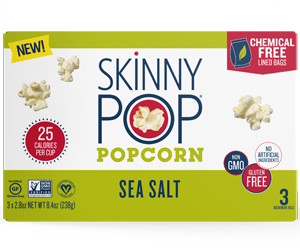
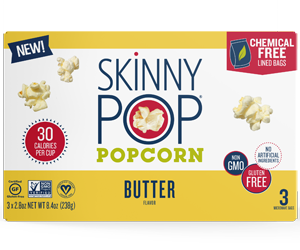
Skinny Pop’s microwave popcorn is not organic (although they do have an organic bagged version), but it is one of the safest brands of microwave popcorn in terms of the chemicals and packaging.
Their “chemical-free bag” has no PFAS, and it also contains NO diacetyl.
Skinny Pop’s microwave popcorn comes in two flavors: Sea Salt and (non-dairy) Butter.
Black Jewell
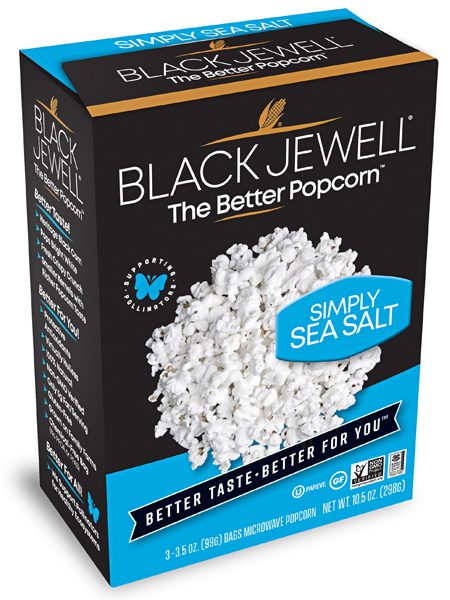
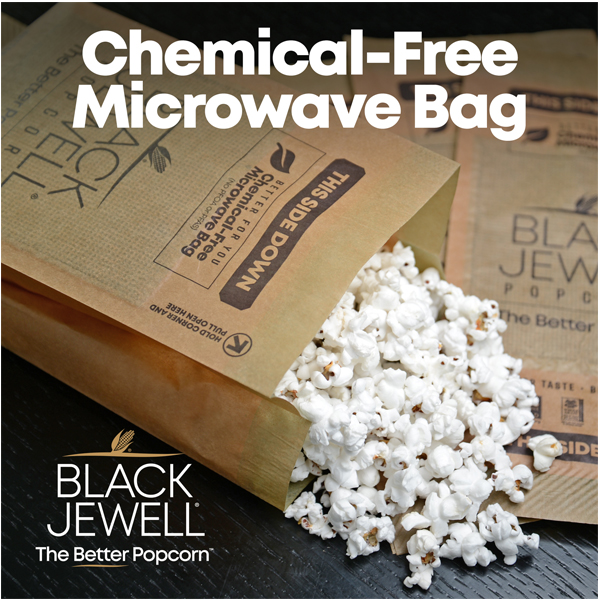
Black Jewell’s corn is grown, harvested, and packaged in the U.S.A. on family farms. It comes in “chemical-free bags” in several different varieties, including Plain, Touch of Butter, Sweet & Salty, and others.
Shop Black Jewell at:
With other brands, it’s virtually impossible to know whether or not it’s truly free of chemicals. Even if the ingredient label is “clean” of potentially toxic ingredients, there is almost no way of knowing the truth about what the packaging is lined with.
Even Better: Switch to Stovetop Popcorn!
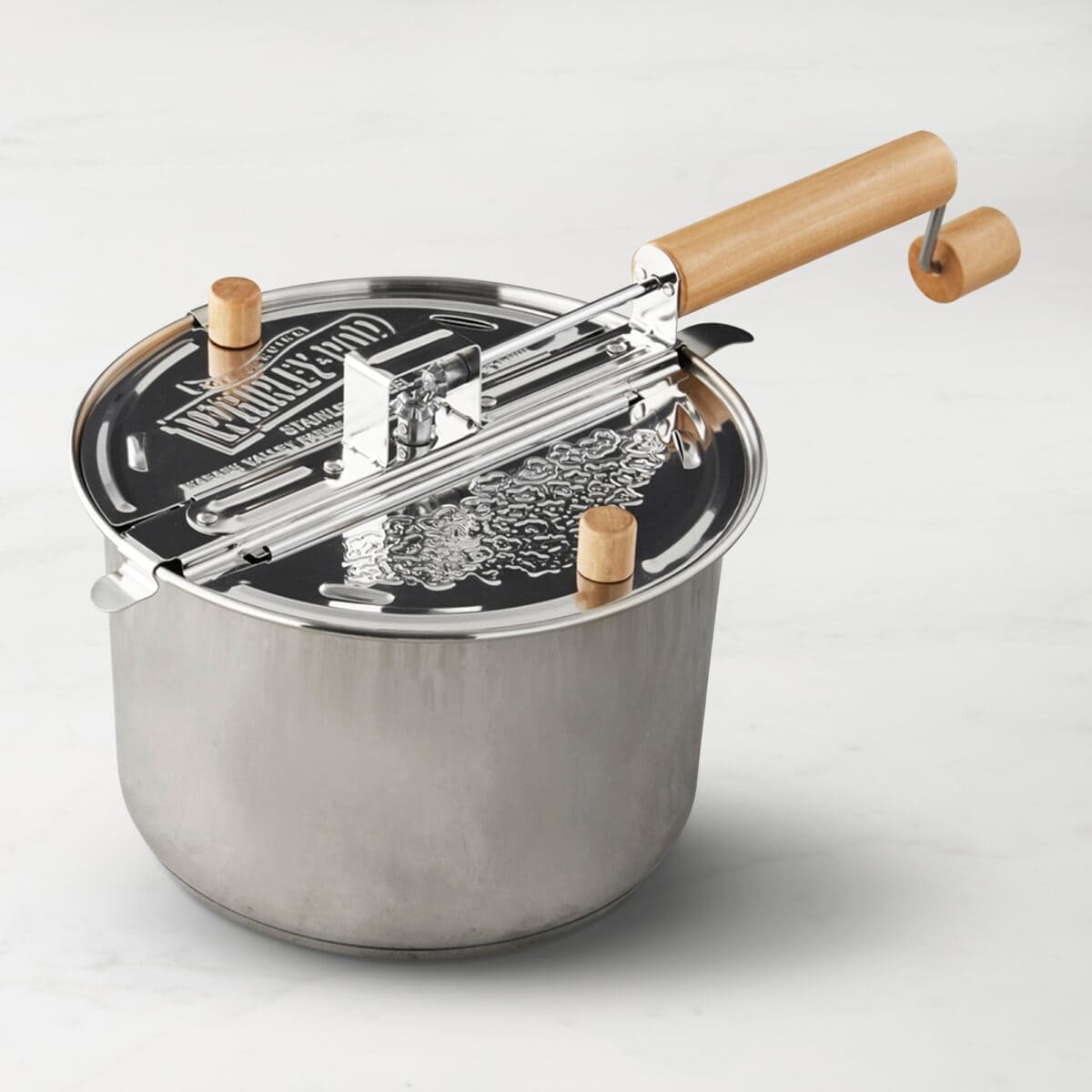
Overall, the best, healthiest popcorn is the kind you make on your stovetop using regular organic popcorn kernels (like these or these).
Even though microwave popcorn might be convenient and save a little bit of time, making popcorn over the stove can be a fun activity with just a small learning curve.
I recommend using one of these Original Whirley Pop stovetop popcorn makers—just add a little bit of avocado or olive oil and some sea salt, and get whirling!
I grew up making Whirley Pop on the stove and I think it not only tastes better, but it’s more fun for the kids. Plus, it’s more customizable. You can add butter, salt, or even do a sugar-cinnamon topping—you choose!
(I emailed Whirley Pop to confirm that their popcorn maker is not lined with PFAS or anything else like that.)
Or, if you don’t want to buy a new piece of cookware, you can just make it using a regular stainless steel pot.
Other Ways To Cook Microwave Popcorn
That said, if you’re set on using the microwave, you can still put regular kernels in the microwave. You don’t even need any oil.
You can do it with either a paper bag (like a lunch sack or a grocery bag) or a plastic-free, microwave-safe bowl and plate.
Here’s how:
If you’re using a paper bag, first make sure there are no holes in the bag and that there aren’t any staples or other metal pieces anywhere.
The amount of kernels to use will differ depending on the size of the container, but usually somewhere around 1/3 of a cup will work. Dump the kernels into the bowl and cover with the plate, or pour them into your paper bag and fold over the top down a few times to hold it closed.
The most important part about putting regular popcorn in the microwave to make sure and listen for when it’s ready! When the popping slows to about 2 seconds in between pops, that’s when it’s time to take the popcorn out in order to prevent it from getting burnt. The exact length of time will depend on your microwave and container size, but usually between 2 and 4 minutes in the microwave will do the trick.
You can also pop popcorn over an open fire or on a grill!
TL;DR: Is Microwave Popcorn Bad For You?
Unfortunately, most microwave popcorn on the market is not healthy. The bags often come lined with toxic chemicals, and many brands still contain additives that can lead to longterm health concerns (although some of these ingredients have been largely phased out over the past decade).
However, there are plenty of healthier brands to choose from. If you’re going to go for microwave popcorn, choose Skinny Pop or Black Jewell. Or better yet, just skip the bag and use regular organic popcorn kernels and make them on the stovetop!



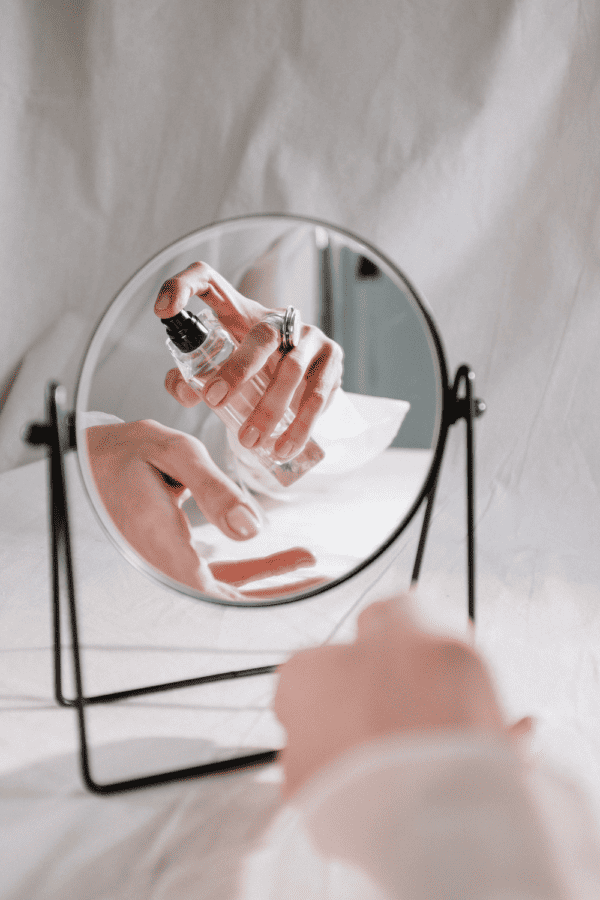

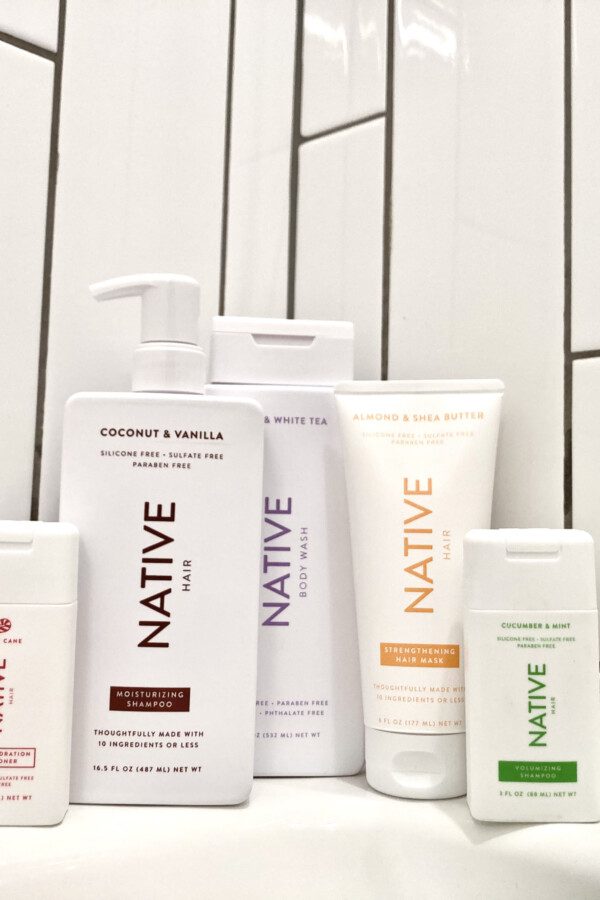
Best: No bags of any sort with popcorn. No chemically treated or butter treated kernels.
My Recommendation that I have enjoyed over the years: Corn, the whole corn, and nothing but corn.
Place in medium pryex glass bowl and add only 100% natural corn to cover the bottom of the bowl. (It doesn’t take much.) Pour about a tablespoon of Extra Virgin Olive Oil over the kernels, or spray olive oil over the kernels.
Place in the microwave and most importantly, cover the bowl with a glass plate.
Set the microwave to 2 minutes. (This prevents overcooked burned corn.)
After 2 minutes, transfer popped corn into another bowl for your enjoyment.
Place remaining un-popped kernels in microwave for 1 minute.
Share your totally wholesome fresh all natural popped corn with your dog. He will love it.
Enjoy Life with all natural foods. They are at your local WalMart if you are smart enough to say, To Hell with altered foods and To Heaven with God’s.
Stephen Juneau
Share with your dog or he will not be pleased.
Put remaining
Thanks for the tips, Stephen!